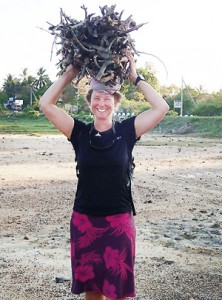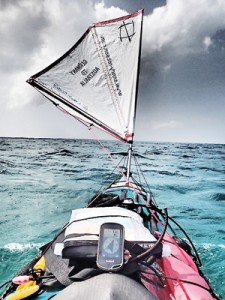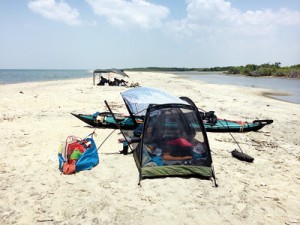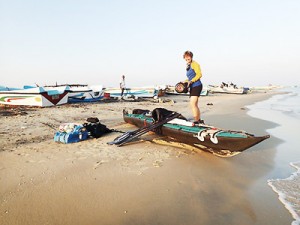Paddling solo halfway across the world
 Her Dad follows her on a world map back home in Western Australia every day, while her Mom only wishes to know whether she is safe. It is not just wanderlust which has gripped 43-year-old Sandy Robson but a unique “dream”. Inseparable have been Sandy and her kayak, with her travels using this mode of transport beginning from Ulm in Germany, down the Danube, with the final destination being Australia. Her kayaking expedition, in stages, launched in May 2011 is to end only in 2016, although in-between she does visit home, on and off.
Her Dad follows her on a world map back home in Western Australia every day, while her Mom only wishes to know whether she is safe. It is not just wanderlust which has gripped 43-year-old Sandy Robson but a unique “dream”. Inseparable have been Sandy and her kayak, with her travels using this mode of transport beginning from Ulm in Germany, down the Danube, with the final destination being Australia. Her kayaking expedition, in stages, launched in May 2011 is to end only in 2016, although in-between she does visit home, on and off.
Having nearly gone around Sri Lanka, with only about 10 days left for her to complete her 40-day round trip of the island, starting and ending at Talaimannar, the Sunday Times caught up with her in Vakarai on Monday night after dinner, for a chat on her mobile.

Sandy’s kayak in choppy seas (Photos courtesy of Sandy Robson’s blog)
Sandy and her five-year sea-kayaking expedition are very special for Sri Lanka, as now there is a world record within reach. “I’m the first to go around your beautiful island in a kayak,” she says. It was an “amazing story” of another’s journey from Germany to Australia that made Sandy take up her dream and follow not in the footsteps of German Oskar Speck but along his sea-kayaking wake.
Based in Western Australia “doing a lot of different things” but kayaking being her passion, she was determined to re-trace Speck’s journey when she heard how he had paddled all the way from Germany to Australia. (See box)
Sandy hopes to paddle a breathtaking 50,000km alone in her kayak. Now into Stage 3 of her journey which is Sri Lanka and India’s east coast, she says that although it is a really long journey, it’s a historic one and also a fun way to see the world. She set off from Ulm armed with an Admiralty Chart which would give her clues about the tides and depths of the sea, a GPS and the daily weather forecast. Sometimes, however, not gaining immigration permission made her change course and the examples she cites are her inability to cross to Iran from Turkey and also Syria, while Iraq became a no-go zone for her due to fears of mines in the River Euphrates planted by former leader Saddam Hussein’s army.

The team which helped Sandy in Sri Lanka in early April
Another time when immigration paper issues delayed her journey was after she had done her paddling along the west coast and east coast of India and had to kick her heels in Chennai as her Indian papers had been delayed. Keeping a clear eye on the “weather window”, although she had originally planned to make a crossing from Adam’s Bridge between India and Sri Lanka, she had realised that a quick decision was needed.
If she were to beat the strong winds which were very much part of the southwest monsoon, she would have to begin her Sri Lankan round-trip soon. It was then that she made up her mind to fly down to Colombo from Chennai and get a friend in Negombo to drive her to Talaimannar and set about paddling south from there on March 23.
Having clocked 800km up to April 14, from Vakarai her next stop was Trincomalee in three days and the more she paddles around the country she says her mind goes, “Wow, so many beautiful places” which she is making a “big list” of to come back to at leisure. “I’m not a normal tourist and don’t have the time to do tourist things on this expedition,” says Sandy, adding that along the coastline, Sri Lankan hospitality has been fantastic. Although she does stay at hotels if there is no other place, her choice is putting up her small tent in her “million-star hotel” under the inky-blue skies in the open-air.

Camping under a saree-shade shelter in the north
This was particularly true in the north of Sri Lanka where there are fewer tourist places and she laughingly adds that her Mom needn’t worry while she is paddling around this country because the Navy has been helping her, checking on her and advising her on safe places to camp. At Vakarai, Sandy says she is in a “lovely place, a simple little cottage with the shower outside” while the previous night it was at Passekudah at a spot where the fishermen berthed their boats and the night watchman who could speak a smattering of English had a long chat with her.
The best part throughout her kayaking expedition is the people that she meets, mostly fishermen. They would look at the kayak, touch it tenderly and admire it and she in turn would look at their craft. She too feels respect and love for the kayak, which she calls “a pretty amazing and versatile boat” that can be paddled in places where no other boats can go, in shallow waters. Generally used by Eskimos, even if it turns turtle, one can go into an ‘Eskimo roll’ and get back up again, says Sandy who sometimes gets a little help from the sail set to the wind, to glide on a little faster.
When asked whether she has fears about her personal safety, Sandy is quick to respond that she feels the biggest danger would be posed by men drinking alcohol because their actions would be unpredictable. However, having kayaked along the west coast of India, she has gained experience on how to handle such situations. “I got the best training there.”
While an anxious moment for her in Gujarat was when she was robbed of her sparse food stock as well as her camping gear and also her cooking stove and even her shoes, she says that someone would always appear to help her. She was desperate and this was in Gujarati villages where no one spoke English. Suddenly though this Indian with “like a market in the back of his vehicle” had appeared and to her plaintive cry of how she could cook her meagre meals had produced a silver cooking pot and several packets of mothballs.
 The mothballs could be set alight and she was able to boil water and make noodles, she says, adding that till she reached Mumbai, it was the ‘mothball cooker’ that came in handy. There have also been the “crazy moments” for her such as when about 400 villagers in India surrounded her kayak and another time when she went ashore expecting a small hotel where she could lay down her weary head, she found to her dismay that it had been swept away by the December 2004 tsunami.
The mothballs could be set alight and she was able to boil water and make noodles, she says, adding that till she reached Mumbai, it was the ‘mothball cooker’ that came in handy. There have also been the “crazy moments” for her such as when about 400 villagers in India surrounded her kayak and another time when she went ashore expecting a small hotel where she could lay down her weary head, she found to her dismay that it had been swept away by the December 2004 tsunami.
Another incident she will never forget is when the Indian Coastguard suddenly dropped from a helicopter to check out why she was paddling next to a fort.
Things work out and unexpected people turn up to help, Sandy points out, adding that many people who hear through the media about her unusual journey, contact her and offer assistance in the form of accommodation or sponsorship for which she is grateful as her expedition is very costly.
In Sri Lanka, there have been strenuous stretches for Sandy, like the full day and night she was at sea, paddling more than 100km because she did not have a permit to camp at Yala and Kumana National Parks, arriving at Arugam Bay at 6.30 in the morning. A worrisome moment had been when she had paddled into Passekudah and was enjoying a coffee with some friendly occupants of a catamaran, while watching a police boat approaching them. A near-miss it had been, for the police boat had nearly rammed, by accident of course, her kayak and it had only been her foresight in jumping into the water and pushing it away that had saved the day.
For Sandy, heat rash, sunburn, blisters and salt sores apart, as well as “pretty basic food” such as crackers, cheese, canned fish, muesli, nuts and chocolates she pops into her mouth and munches every hour “to sustain the calories” while on the go in the kayak itself, she feels it is fully worth it because she is doing something she loves – paddling and “following my dream”.
When she returns to Talaimannar, it will be time to set her sights on the east coast of India through the Palk Straits, where she would pick up her red kayak and head for Bangladesh, Myanmar, Thailand, Malaysia, Singapore, Indonesia, Papua New Guinea and finally Australia. Yes, she would be checking the weather forecast and staying on land if a storm is brewing and also keeping an eye on the gale-force winds of the southwest monsoon which she would hasten to beat when heading for the east coast of India. But it would not be before partying on reaching Talaimannar – for Sandy is the first to kayak around Sri Lanka, setting a world record.
An inspiring journey
Oskar Speck set out in a folding kayak on the Danube River in 1932, Sandy says in her blog, painting an image of the person who made her launch her own kayak into the world’s seas.
She states: “Seven years, several kayaks and many thousands of kilometres later, he landed in Australian waters. Inspired by what has to be one of the most amazing kayak journeys of all time, I am retracing the Speck route across the world in a kayak. Living simply out of a kayak, I have found out that there are many things in life that we can do without, but dreams are not one of those things.”
Stage I of Sandy’s expedition began from Ulm on the Danube on May 14, 2011, the same day that Oskar departed in 1932. Sandy paddled through Germany, Austria, Slovakia, Hungary, Croatia and Serbia and on reaching the Bulgarian border followed the Speck route overland to the Vardar River in Macedonia, kayaking thereon from Macedonia to Greece and the Aegean Sea near Thessaloniki. There she island-hopped across the Aegean Sea through Greece to Marmaris in Turkey, following the coast to Taucu. Taking the ferry to Cyprus, she paddled the northern coastline to the monastery where Oskar stayed at Cape Andreas before his crossing to Syria, going as far as she could on the Turkish Cypriot side of the ‘Green Line’ that divides Cyprus.
Stage 2 began on the northwest coast of India near Jamnagar, coming down to Kanyakumari on the southern tip and then up the east coast of Tamil Nadu to the northern side of Palk Bay to Vederanyam.
Stage 3 is circumnavigating Sri Lanka and then paddling north up the east coast of India.
Sandy’s expedition may be followed through her blog: www.sandy-robson.com.


